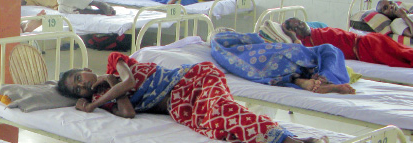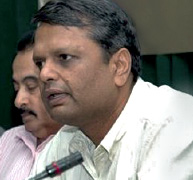 |
|
|
|
|

The transition was stark. We were making a documentary with a team from DNDi on clinical trials in India. One day we were filming in a luxurious Delhi hospital catering for wealthy patients and foreigners; the next, we were in the middle of Bihar, one of India’s poorest states. The contrast is huge between the glittering sparkle of India’s major cities and the misery of rural provincial India. Muzaffarpur is a good example of the latter: the centre of an agricultural area of Bihar where approximately one million people live, crowding the dusty narrow roads.

Community-based solutions
Muzaffarpur is a fairly typical small town in India. In terms of infrastructure, it has a university, and a public hospital - both serving the needs of the population, but not ‘state-of-the–art’. Against this backdrop, The ‘Kala-Azar Medical Research Centre’, established by Dr Shyam Sundar, very much stands out. A specialist treatment and clinical research centre located among small shops and rundown houses, it is a surprising but reassuring feature. Dr Sundar was born and raised in India. He decided to forsake a promising academic career to devote himself instead to the fight against leishmaniasis, a disease that has ravaged the region where he was born. Each year, a quarter of a million Biharis are infected with kala-azar, the ‘black fever’ that affects and kills the poorest of the poor.
 Dr Shyam Sundar established the first centre dedicated to the diagnosis and treatment of visceral leishmaniasis in Muzaffarpur, in the Indian state of Bihar |
Hunger or healthcare
“Just to illustrate the dire conditions my patients find themselves in: during a consultation in a remote village, I gave the equivalent of one dollar in rupees to the parents of a sick child to pay for the bus to the medical centre in Muzaffarpur. The child never showed up to take the treatment, which of course was free of charge. A few weeks later he died of leishmaniasis”. The parents failed to bring the sick child to Dr Sundar simply because they had little choice but to spend the transport money to feed their family.
In this context of extreme economic hardship, it is a real challenge to effectively control ‘black fever’. None of the patients can afford to pay for even the most basic treatment. A market made up of povertystricken people is of no interest to the pharmaceutical industry whose priorities and profits lie elsewhere. Professor Sundar’s team can only rely on their own efforts and the support of Drugs for Neglected Diseases initiative (DNDi) and Institute of One World Health to develop a new, simple, and affordable treatment to eradicate leishmaniasis once and for all.
Testing ground for ‘western’ cures
Research is making progress, and clinical studies are ongoing in Muzaffarpur. Yet, despite support from various partners, the sources of funding are insignificant in comparison to the hundreds of millions of dollars invested in India each year by multinational pharmaceutical companies for testing new drugs to treat obesity, hypertension, osteoporosis and other ‘western’ diseases. The clinical trials business is booming in India, keeping researchers, laboratories, and luxurious hospitals busy.
This, of course, is the reality in Delhi, Mumbai, and Bangalore, far from the paddy fields of Muzaffarpur, hard hit by the fever of the poor.